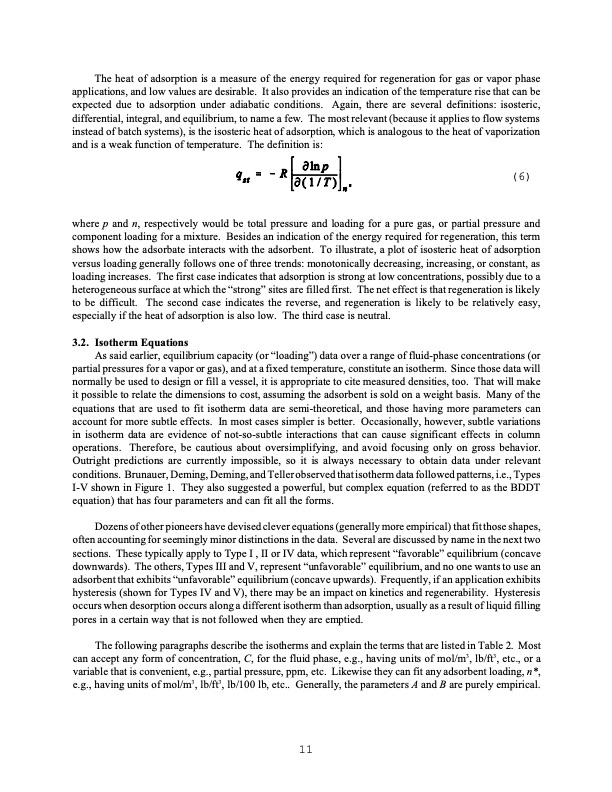
PDF Publication Title:
Text from PDF Page: 013
The heat of adsorption is a measure of the energy required for regeneration for gas or vapor phase applications, and low values are desirable. It also provides an indication of the temperature rise that can be expected due to adsorption under adiabatic conditions. Again, there are several definitions: isosteric, differential, integral, and equilibrium, to name a few. The most relevant (because it applies to flow systems instead of batch systems), is the isosteric heat of adsorption, which is analogous to the heat of vaporization and is a weak function of temperature. The definition is: (6) where p and n, respectively would be total pressure and loading for a pure gas, or partial pressure and component loading for a mixture. Besides an indication of the energy required for regeneration, this term shows how the adsorbate interacts with the adsorbent. To illustrate, a plot of isosteric heat of adsorption versus loading generally follows one of three trends: monotonically decreasing, increasing, or constant, as loading increases. The first case indicates that adsorption is strong at low concentrations, possibly due to a heterogeneous surface at which the “strong” sites are filled first. The net effect is that regeneration is likely to be difficult. The second case indicates the reverse, and regeneration is likely to be relatively easy, especially if the heat of adsorption is also low. The third case is neutral. 3.2. Isotherm Equations As said earlier, equilibrium capacity (or “loading”) data over a range of fluid-phase concentrations (or partial pressures for a vapor or gas), and at a fixed temperature, constitute an isotherm. Since those data will normally be used to design or fill a vessel, it is appropriate to cite measured densities, too. That will make it possible to relate the dimensions to cost, assuming the adsorbent is sold on a weight basis. Many of the equations that are used to fit isotherm data are semi-theoretical, and those having more parameters can account for more subtle effects. In most cases simpler is better. Occasionally, however, subtle variations in isotherm data are evidence of not-so-subtle interactions that can cause significant effects in column operations. Therefore, be cautious about oversimplifying, and avoid focusing only on gross behavior. Outright predictions are currently impossible, so it is always necessary to obtain data under relevant conditions. Brunauer, Deming, Deming, and Teller observed that isotherm data followed patterns, i.e., Types I-V shown in Figure 1. They also suggested a powerful, but complex equation (referred to as the BDDT equation) that has four parameters and can fit all the forms. Dozens of other pioneers have devised clever equations (generally more empirical) that fit those shapes, often accounting for seemingly minor distinctions in the data. Several are discussed by name in the next two sections. These typically apply to Type I , II or IV data, which represent “favorable” equilibrium (concave downwards). The others, Types III and V, represent “unfavorable” equilibrium, and no one wants to use an adsorbent that exhibits “unfavorable” equilibrium (concave upwards). Frequently, if an application exhibits hysteresis (shown for Types IV and V), there may be an impact on kinetics and regenerability. Hysteresis occurs when desorption occurs along a different isotherm than adsorption, usually as a result of liquid filling pores in a certain way that is not followed when they are emptied. The following paragraphs describe the isotherms and explain the terms that are listed in Table 2. Most can accept any form of concentration, C, for the fluid phase, e.g., having units of mol/m3, lb/ft3, etc., or a variable that is convenient, e.g., partial pressure, ppm, etc. Likewise they can fit any adsorbent loading, n*, e.g., having units of mol/m3, lb/ft3, lb/100 lb, etc.. Generally, the parameters A and B are purely empirical. 11PDF Image | ADSORBENT SELECTION

PDF Search Title:
ADSORBENT SELECTIONOriginal File Name Searched:
AdsorbentSel1B.pdfDIY PDF Search: Google It | Yahoo | Bing
CO2 Organic Rankine Cycle Experimenter Platform The supercritical CO2 phase change system is both a heat pump and organic rankine cycle which can be used for those purposes and as a supercritical extractor for advanced subcritical and supercritical extraction technology. Uses include producing nanoparticles, precious metal CO2 extraction, lithium battery recycling, and other applications... More Info
Heat Pumps CO2 ORC Heat Pump System Platform More Info
| CONTACT TEL: 608-238-6001 Email: greg@infinityturbine.com | RSS | AMP |